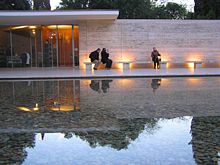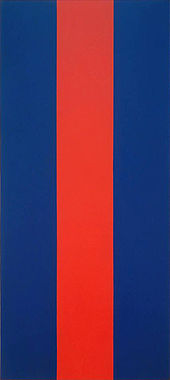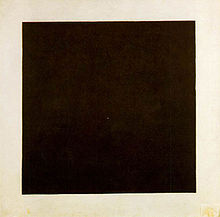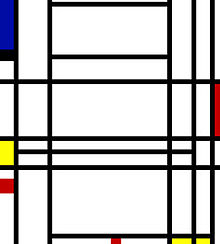- Minimalism
-
Minimalism describes movements in various forms of art and design, especially visual art and music, where the work is stripped down to its most fundamental features. As a specific movement in the arts it is identified with developments in post–World War II Western Art, most strongly with American visual arts in the 1960s and early 1970s. Prominent artists associated with this movement include Donald Judd, John McCracken, Agnes Martin, Dan Flavin, Robert Morris, Anne Truitt, and Frank Stella. It is rooted in the reductive aspects of Modernism, and is often interpreted as a reaction against Abstract expressionism and a bridge to Postminimal art practices.
The terms have expanded to encompass a movement in music which features repetition and iteration, as in the compositions of La Monte Young, Terry Riley, Steve Reich, Philip Glass, and John Adams. Minimalist compositions are sometimes known as systems music.
The term "minimalist" is often applied colloquially to designate anything which is spare or stripped to its essentials. It has also been used to describe the plays and novels of Samuel Beckett, the films of Robert Bresson, the stories of Raymond Carver, and even the automobile designs of Colin Chapman. The word was first used in English in the early 20th century to describe the Mensheviks.[1]
Contents
Minimalist design
The term minimalism is also used to describe a trend in design and architecture where in the subject is reduced to its necessary elements. Minimalist design has been highly influenced by Japanese traditional design and architecture. In addition, the work of De Stijl artists is a major source of reference for this kind of work. De Stijl expanded the ideas that could be expressed by using basic elements such as lines and planes organized in very particular manners.
Architect Ludwig Mies van der Rohe adopted the motto "Less is more" to describe his aesthetic tactic of arranging the numerous necessary components of a building to create an impression of extreme simplicity, by enlisting every element and detail to serve multiple visual and functional purposes (such as designing a floor to also serve as the radiator, or a massive fireplace to also house the bathroom). Designer Buckminster Fuller adopted the engineer's goal of "Doing more with less", but his concerns were oriented towards technology and engineering rather than aesthetics. A similar sentiment was industrial designer Dieter Rams' motto, "Less but better" adapted from van der Rohe. The structure uses relatively simple elegant designs; ornamentations are quality rather than quantity[dubious ]. The structure's beauty is also determined by playing with lighting, using the basic geometric shapes as outlines, using only a single shape or a small number of like shapes for components for design unity, using tasteful non-fussy bright color combinations, usually natural textures and colors, and clean and fine finishes. Using sometimes the beauty of natural patterns on stone cladding and real wood encapsulated within ordered simplified structures, and real metal producing a simplified but prestigious architecture and interior design. May use color brightness balance and contrast between surface colors to improve visual aesthetics. The structure would usually have industrial and space age style utilities (lamps, stoves, stairs, technology, etc.), neat and straight components (like walls or stairs) that appear to be machined with machines, flat or nearly flat roofs, pleasing negative spaces, and large windows to let in lots of sunlight. This and science fiction may have contributed to the late twentieth century futuristic architecture design, and modern home decor. Modern minimalist home architecture with its unnecessary internal walls removed probably have led to the popularity of the open plan kitchen and living room style.
Another modern master who exemplifies reductivist ideas is Luis Barragán. In minimalism, the architectural designers pay special attention to the connection between perfect planes, elegant lighting, and careful consideration of the void spaces left by the removal of three-dimensional shapes from an architectural design. The more attractive looking minimalist home designs are not truly minimalist, because these use more expensive building materials and finishes, and are relatively larger.
Contemporary architects working in this tradition include John Pawson, Eduardo Souto de Moura, Álvaro Siza Vieira, Tadao Ando, Alberto Campo Baeza, Yoshio Taniguchi, Peter Zumthor, Hugh Newell Jacobsen, Vincent Van Duysen, Claudio Silvestrin, Michael Gabellini, and Richard Gluckman.[2]
Minimalist Architecture and Space
The term ‘minimalism’ is a trend from early 19th century and gradually became an important movement in response to the over decorated design of the previous period. Minimalist architecture became popular in the late 1980s in London and New York.[3] Where architects and fashion designers worked together in the boutiques to achieve simplicity, using white elements, cold lighting, large space with minimum objects and furniture. Minimalist architecture simplifies living space to reveal the essential quality of buildings and conveys simplicity in attitudes toward life. It is highly inspired from the Japanese traditional design and the concept of Zen philosophy.
Concepts and Design Elements
The concept of minimalist architecture is to strip everything down to its essential quality and achieve simplicity.[4] The idea is not completely without ornamentation,[5] but that all parts, details and joinery are considered as reduced to a stage where no one can remove anything further to improve the design.[6]
The considerations for ‘essences’ are light, form, detail of material, space, place and human condition.[7] Minimalist architects not only consider the physical qualities of the building. Moreover, they look deeply into the spiritual dimension and the invisible, by listen to the figure and pay attention to the details, people, space, nature and materials.[8] Which reveals the abstract quality of something that is invisible and search for the essence from those invisible qualities. Such as natural light, sky, earth and air. In addition, they open up dialogue with the surrounding environment to decide the most essential materials for the construction and create relationships between buildings and sites.[9]
In minimalist architecture, design elements convey the message of simplicity. The basic geometric forms, elements without decoration, simple materials and the repetitions of structures represent a sense of order and essential quality.[10]The movement of natural light in buildings reveals simple and clean spaces.[11] In late 19th century as the arts and crafts movement began popular in Britain, people values the attitude of ‘truth to materials’, which respect the profound and innate characteristic of materials.[12] They manipulate humility attitude towards material by listen to it, which is ‘listen to figure’ and try to find out every essentiality from the identity of material. Therefore minimalist architects benefit from seeking the essence and simplicity by rediscovers the valuable qualities in the simple and common materials.[13]
Influences from Japanese tradition
The idea of simplicity appears in many cultures, especially the Japanese traditional culture of Zen Philosophy. Japanese manipulate the Zen culture into aesthetic and design elements for their buildings.[14] This idea of architecture has influenced Western Society, especially in America since the mid 18th century.[15] Moreover, it inspired the minimalist architecture in the 19th century.[16]
Zen concepts of simplicity transmit the ideas of freedom and essence of living.[17] Simplicity is not only aesthetic value, it has a moral perception that looks into the nature of truth and reveals the inner qualities of materials and objects for the essence.[18] For example, the sand garden in Ryoanji temple demonstrates the concept of simplicity and the essentiality from the considered setting of a few stones and a huge empty space.[19]
The Japanese aesthetic principle of Ma[disambiguation needed
 ] refers to empty or open space. That removes all the unnecessary internal walls and opens up the space between interior and the exterior. Frank Lloyd Wright was influenced by the design element of Japanese sliding door that allows to bring the exterior to the interior.[20] The emptiness of spatial arrangement is another idea that reduces everything down to the most essential quality.[21]
] refers to empty or open space. That removes all the unnecessary internal walls and opens up the space between interior and the exterior. Frank Lloyd Wright was influenced by the design element of Japanese sliding door that allows to bring the exterior to the interior.[20] The emptiness of spatial arrangement is another idea that reduces everything down to the most essential quality.[21]The Japanese aesthetic of Wabi values the quality of simple and plain objects.[22] It appreciates the absence of unnecessary features to view life in quietness and reveals the most innate character of materials.[23] For example, the Japanese flora art, also known as Ikebana has the meaning of let flower express itself. People cut off the branches, leaves and blossoms from the plants and only retain the essential part from the plant. Which conveys the idea of essential quality and innate character in nature.[24]
Minimalist architects and their works
The Japanese minimalist architect, Tadao Ando conveys the Japanese traditional spirit and his own perception of nature in his works. His design concepts are materials, pure geometry and nature. He normally uses concrete or natural wood and basic structural form to achieve austerity and rays of light in space. He also sets up dialogue between the site and nature to create relationship and order with the buildings.[25] Ando’s works and the translation of Japanese aesthetic principles are highly influential on Japanese architecture.[26]
In Vitra Conference Pavilion, Weil am Rhein, 1993, the concepts are to bring together the relationships between building, human movement, site and nature. Which as one main point of minimalism ideology that establish dialogue between the building and site. The building uses the simple forms of circle and rectangle to contrast the filled and void space of the interior and nature. In the foyer, there is a large landscape window that looks out to the exterior. This achieves the simple and silence of architecture and enhances the light, wind, time and nature in space.[27]
John Pawson is a British minimalist architect, his design concepts are soul, light and order. He believes that though reduced clutter and simplification of the interior to a point that gets beyond the idea of essential quality, there is a sense of clarity and richness of simplicity instead of emptiness. The materials in his design reveal the perception toward space, surface and volume. Moreover, he likes to use natural materials because of their aliveness, sense of depth and quality of individual. He is also attracted by the important influences from Japanese Zen Philosophy.[28]
Calvin Klein Madison Avenue, New York, 1995-96, is a boutique that conveys Galvin Klein’s ideas of fashion. John Pawson’s interior design concepts for this project are to create simple, peaceful and orderly spatial arrangements. He used stone floors and white walls to achieve simplicity and harmony for space. He also emphasises reduction and eliminates the visual distortions, such as the air conditioning and lamps to achieve a sense of purity for interior.[29]
Alberto Campo Baeza is a Spanish architect and describes his work as essential architecture. He values the concepts of light, idea and space. Light is essential and achieves the relationship between inhabitants and the building. Ideas are to meet the function and context of space, forms and construction. Space is shaped by the minimal geometric forms to avoid decoration that is not essential.[30]
Gasper House, Zahora, 1992 is a residence that client requested to be independent. High walls create the enclosed space and the stone floors used in house and courtyard show the continuality of interior and exterior. The white colour of the walls reveals the simplicity and unity of the building. The feature of the structure make lines to form the continuously horizontal house, therefore natural light projects horizontally through the building.[31]
Minimal Art, Minimalism in visual art
Minimalism in visual art, generally referred to as Minimal Art, literalist art[32] and ABC Art[33] emerged in New York in the early 1960s. Initially minimal art appeared in New York in the 60s as new and older artists moved toward geometric abstraction; exploring via painting in the cases of Frank Stella, Kenneth Noland, Al Held, Ellsworth Kelly, Robert Ryman and others; and sculpture in the works of various artists including David Smith, Anthony Caro, Tony Smith, Sol LeWitt, Carl Andre, Dan Flavin, Donald Judd and others. Judd's sculpture were showcased in 1964 at the Green Gallery in Manhattan, while other leading Manhattan galleries like the Leo Castelli Gallery and the Pace Gallery also began to showcase artists focused on geometric abstraction. In addition there were two seminal and influential museum exhibitions: Primary Structures: Younger American and British Sculpture' shown from April 27 - June 12, 1966 at the Jewish Museum in New York, organized by the museum's Curator of Painting and Sculpture, Kynaston McShine [34] [35] and Systemic Painting, at the Solomon R. Guggenheim Museum curated by Lawrence Alloway also in 1966 that showcased Geometric abstraction in the American art world via Shaped canvas, Color Field, and Hard-edge painting. [36] [37]In the wake of those exhibitions and a few others the art movement called minimal art emerged.
In a much more broad and general sense, one might, in fact, find European roots of Minimalism in the geometric abstractions of painters in the Bauhaus, in the works of Piet Mondrian and other artists associated with the De Stijl movement, in the Russian Constructivist movement, and in the work of the Romanian sculptor Constantin Brâncuşi. Minimal art is also inspired in part by the paintings of Barnett Newman, Ad Reinhardt, Josef Albers, and the works of artists as diverse as Pablo Picasso, Marcel Duchamp, Giorgio Morandi, and others. It is regarded as a reaction against the painterly subjectivity of Abstract Expressionism as well as the discourse, institutions and ideologies that promoted Abstract Expressionism.
Artist and critic Thomas Lawson noted in his 1977 catalog essay Last Exit: Painting, minimalism did not reject Clement Greenberg's claims about modernist painting's [38] reduction to surface and materials so much as take his claims literally. According to Lawson minimalism was the result, even though the term "minimalism" was not generally embraced by the artists associated with it, and many practitioners of art designated minimalist by critics did not identify it as a movement as such. Also taking exception to this claim was Clement Greenberg himself; in his 1978 postscript to his essay Modernist Painting he disavowed this incorrect interpretation of what he said; Greenberg wrote:
There have been some further constructions of what I wrote that go over into preposterousness: That I regard flatness and the inclosing of flatness not just as the limiting conditions of pictorial art, but as criteria of aesthetic quality in pictorial art; that the further a work advances the self-definition of an art, the better that work is bound to be. The philosopher or art historian who can envision me -- or anyone at all -- arriving at aesthetic judgments in this way reads shockingly more into himself or herself than into my article. [39]
In contrast to the to the previous decade's more subjective Abstract Expressionists, with the exceptions of Barnett Newman and Ad Reinhardt, minimalists were influenced by composers John Cage and LaMonte Young, poet William Carlos Williams, and the landscape architect Frederick Law Olmsted. They very explicitly stated that their art was not about self-expression, unlike the previous decade's more subjective philosophy about art making theirs was objective. In general, Minimalism's features included geometric, often cubic forms purged of much metaphor, equality of parts, repetition, neutral surfaces, and industrial materials.
Robert Morris, an influential theorist and artist, wrote a three part essay, "Notes on Sculpture 1-3", originally published across three issues of Artforum in 1966. In these essays, Morris attempted to define a conceptual framework and formal elements for himself and one that would embrace the practices of his contemporaries. These essays paid great attention to the idea of the gestalt - "parts... bound together in such a way that they create a maximum resistance to perceptual separation." Morris later described an art represented by a "marked lateral spread and no regularized units or symmetrical intervals..." in "Notes on Sculpture 4: Beyond Objects", originally published in Artforum, 1969, continuing to say that "indeterminacy of arrangement of parts is a literal aspect of the physical existence of the thing." The general shift in theory of which this essay is an expression suggests the transitions into what would later be referred to as postminimalism.
One of the first artists specifically associated with minimalism was the painter, Frank Stella, whose early "pinstripe" paintings were included in the 1959 show, 16 Americans, organized by Dorothy Miller at the Museum of Modern Art in New York. The width of the stripes in Frank Stellas's pinstripe paintings were determined by the dimensions of the lumber used for stretchers, visible as the depth of the painting when viewed from the side, used to construct the supportive chassis upon which the canvas was stretched. The decisions about structures on the front surface of the canvas were therefore not entirely subjective, but pre-conditioned by a "given" feature of the physical construction of the support. In the show catalog, Carl Andre noted, "Art excludes the unnecessary. Frank Stella has found it necessary to paint stripes. There is nothing else in his painting." These reductive works were in sharp contrast to the energy-filled and apparently highly subjective and emotionally-charged paintings of Willem de Kooning or Franz Kline and, in terms of precedent among the previous generation of abstract expressionists, leaned more toward the less gestural, often somber, color field paintings of Barnett Newman and Mark Rothko. Although Stella received immediate attention from the MoMA show, artists including Kenneth Noland, Gene Davis, Robert Motherwell and Robert Ryman had also begun to explore stripes, monochromatic and Hard-edge formats from the late 50s through the 1960s.[40]
Because of a tendency in minimal art to exclude the pictorial, illusionistic and fictive in favor of the literal, there was a movement away from painterly and toward sculptural concerns. Donald Judd had started as a painter, and ended as a creator of objects. His seminal essay, "Specific Objects" (published in Arts Yearbook 8, 1965), was a touchstone of theory for the formation of minimalist aesthetics. In this essay, Judd found a starting point for a new territory for American art, and a simultaneous rejection of residual inherited European artistic values. He pointed to evidence of this development in the works of an array of artists active in New York at the time, including Jasper Johns, Dan Flavin and Lee Bontecou. Of "preliminary" importance for Judd was the work of George Earl Ortman,[41] who had concretized and distilled painting's forms into blunt, tough, philosophically charged geometries. These Specific Objects inhabited a space not then comfortably classifiable as either painting or sculpture. That the categorical identity of such objects was itself in question, and that they avoided easy association with well-worn and over-familiar conventions, was a part of their value for Judd.
This movement was heavily criticised by modernist formalist art critics and historians. Some critics thought minimal art represented a misunderstanding of the modern dialectic of painting and sculpture as defined by critic Clement Greenberg, arguably the dominant American critic of painting in the period leading up to the 1960s. The most notable critique of minimalism was produced by Michael Fried, a formalist critic, who objected to the work on the basis of its "theatricality". In Art and Objecthood (published in Artforum in June 1967) he declared that the minimal work of art, particularly minimal sculpture, was based on an engagement with the physicality of the spectator. He argued that work like Robert Morris's transformed the act of viewing into a type of spectacle, in which the artifice of the act observation and the viewer's participation in the work were unveiled. Fried saw this displacement of the viewer's experience from an aesthetic engagement within, to an event outside of the artwork as a failure of minimal art. Fried's essay was immediately challenged by postminimalist and earth artist Robert Smithson in a letter to the editor in the October issue of Artforum. Smithson stated the following: "What Fried fears most is the consciousness of what he is doing--namely being himself theatrical."
In addition to the already mentioned Robert Morris, Frank Stella, Carl Andre, Robert Ryman and Donald Judd other minimal artists include: Robert Mangold, Larry Bell, Dan Flavin, Sol LeWitt, Brice Marden, Agnes Martin, Jo Baer, John McCracken, Ad Reinhardt, Fred Sandback, Richard Serra, Tony Smith, Blinky Palermo and Anne Truitt.
Ad Reinhardt, actually an artist of the Abstract Expressionist generation, but one whose reductive nearly all-black paintings seemed to anticipate minimalism, had this to say about the value of a reductive approach to art:
The more stuff in it, the busier the work of art, the worse it is. More is less. Less is more. The eye is a menace to clear sight. The laying bare of oneself is obscene. Art begins with the getting rid of nature.
Reinhardt's remark directly addresses and contradicts Hans Hofmann's regard for nature as the source of his own abstract expressionist paintings. In a famous exchange between Hofmann and Jackson Pollock as told by Lee Krasner in an interview with Dorothy Strickler (1964-11-02) for the Smithsonian Institution Archives of American Art. [42] In Krasner's words,
"When I brought Hofmann up to meet Pollock and see his work which was before we moved here, Hofmann’s reaction was — one of the questions he asked Jackson was, do you work from nature? There were no still lifes around or models around and Jackson’s answer was, I am nature. And Hofmann’s reply was, Ah, but if you work by heart, you will repeat yourself. To which Jackson did not reply at all." The meeting between Pollock and Hofmann took place in 1942. [43]
Literary minimalism
Literary minimalism is characterized by an economy with words and a focus on surface description. Minimalist authors eschew adverbs and prefer allowing context to dictate meaning. Readers are expected to take an active role in the creation of a story, to "choose sides" based on oblique hints and innuendo, rather than reacting to directions from the author. The characters in minimalist stories and novels tend to be unexceptional.
Some 1940s-era crime fiction of writers such as James M. Cain and Jim Thompson adopted a stripped-down, matter-of-fact prose style to considerable effect; some classify this prose style as minimalism.
Another strand of literary minimalism arose in response to the Metafiction trend of the 1960s and early 1970s (John Barth, Robert Coover, and William H. Gass). These writers were also spare with prose and kept a psychological distance from their subject matter.
Minimalist authors, or those who are identified with minimalism during certain periods of their writing careers, include the following: Raymond Carver, Ann Beattie, Bret Easton Ellis, Charles Bukowski, Ernest Hemingway, K. J. Stevens, Amy Hempel, Bobbie Ann Mason, Tobias Wolff, Grace Paley, Sandra Cisneros, Mary Robison, Frederick Barthelme, Richard Ford, and Alicia Erian.
American poets such as Stephen Crane, William Carlos Williams, early Ezra Pound, Robert Creeley, Robert Grenier, and Aram Saroyan are sometimes identified with their minimalist style. The term "minimalism" is also sometimes associated with the briefest of poetic genres, haiku, which originated in Japan but has been domesticated in English literature by poets such as Nick Virgilio, Raymond Roseliep, and George Swede.
The Irish author Samuel Beckett is also known for his minimalist plays and prose, as is the Norwegian writer Jon Fosse.
Minimal music
Minimal music is an originally American genre of experimental or Downtown music named in the 1960s based mostly in consonant harmony, steady pulse (if not immobile drones), stasis or gradual transformation, and often reiteration of musical phrases or smaller units such as figures, motifs, and cells. It may include features such as additive process and phase shifting. Starting in the early 1960s as a scruffy underground scene in San Francisco alternative spaces and New York lofts, minimalism spread to become the most popular experimental music style of the late 20th century. The movement originally involved dozens of composers, although only five—Terry Riley, Steve Reich, Philip Glass, John Adams and, less visibly if more seminally, La Monte Young—emerged to become publicly associated with it in America. In Europe, its chief exponents[citation needed] were Louis Andriessen, Karel Goeyvaerts, Michael Nyman, Gavin Bryars, Steve Martland, Henryk Górecki, Arvo Pärt, John Tavener and Martin Rev. The term "minimal music" was derived around 1970 by Michael Nyman from the concept of minimalism, which was earlier applied to the visual arts.[44] For some of the music, especially that which transforms itself according to strict rules, the term "process music" has also been used. Recently, Minimal techno has started gaining popularity among dance music enthusiasts. It takes the same idea that "less is more" from classical composers and applies to this new genre.[citation needed]
See also
- Abstract Imagists
- Capsule wardrobe
- Formalism (art)
- Geometric abstraction
- KISS principle
- Postminimalism
- Shaped canvas
- Simple living
- Verb displacement
Footnotes
- ^ New Oxford American Dictionary (2nd ed., 2005), p. 1079.
- ^ Holm, Ivar (2006). Ideas and Beliefs in Architecture and Industrial design: How attitudes, orientations, and underlying assumptions shape the built environment. Oslo School of Architecture and Design. ISBN 82-547-0174-1.
- ^ Cerver (1997), The Architecture of Minimalism, New York: Hesrst Books international. P8–11.
- ^ Bertoni (2002), Minimalist Architecture, Firenze: Birkhauser.p10.
- ^ Rossell (2005), Minimalist Interiors, New York: HapperCollins. p6.
- ^ Pawson (1996), Minimum, London: Phaidon Press Limited. p7.
- ^ Bertoni (2002), Minimalist Architecture, Firenze: Birkhauser. p15–16.
- ^ Bertoni (2002), Minimalist Architecture, Firenze: Birkhauser. p21.
- ^ Rossell (2005), Minimalist Interiors, New York: HapperCollins. p6.
- ^ Pawson (1996), Minimum, London: Phaidon Press Limited. p8.
- ^ Bertoni (2002), Minimalist Architecture, Firenze: Birkhauser. p15–16.
- ^ Saito, (Winter 2007), The Moral Dimension of Japanese Aesthetics, The Journal of Aesthetics and Art Criticism, vol.65, no. 1. P.87–88.
- ^ Bertoni (2002), Minimalist Architecture, Firenze: Birkhauser. p21.
- ^ Saito, (Winter 2007), The Moral Dimension of Japanese Aesthetics, The Journal of Aesthetics and Art Criticism, vol.65, no. 1. p.85–97.
- ^ Lancaster (September 1953), Japanese Buildings in the United States before 1900: Their Influence upon American Domestic Architecture, The Art Bulletin, vol. 35, no. 3. p217–224.
- ^ Pawson (1996), Minimum, London: Phaidon Press Limited. p7.
- ^ Pawson (1996), Minimum, London: Phaidon Press Limited. p7.
- ^ Saito, (Winter 2007), The Moral Dimension of Japanese Aesthetics, The Journal of Aesthetics and Art Criticism, vol.65, no. 1. p87.
- ^ Pawson (1996), Minimum, London: Phaidon Press Limited. p98.
- ^ Mongabay.com[1].
- ^ Bertoni (2002), Minimalist Architecture, Firenze: Birkhauser. P23.
- ^ Saito, (Winter 2007), The Moral Dimension of Japanese Aesthetics, The Journal of Aesthetics and Art Criticism, vol.65, no. 1. p85.
- ^ Pawson (1996), Minimum, London: Phaidon Press Limited. p10–11.
- ^ Saito, (Winter 2007), The Moral Dimension of Japanese Aesthetics, The Journal of Aesthetics and Art Criticism, vol.65, no. 1.p86.
- ^ Bertoni (2002), Minimalist Architecture, Firenze: Birkhauser p96–106.
- ^ Cerver (1997), The Architecture of Minimalism, New York: Hesrst Books international. p13.
- ^ Cerver (1997), The Architecture of Minimalism, New York: Hesrst Books international. p18–29.
- ^ Pawson (1996), Minimum, London: Phaidon Press Limited. p10-14.
- ^ Cerver (1997), The Architecture of Minimalism, New York: Hesrst Books international. p170–177.
- ^ Bertoni (2002), Minimalist Architecture, Firenze: Birkhauser. p182.
- ^ Bertoni (2002), Minimalist Architecture, Firenze: Birkhauser. p192.
- ^ Fried, M. "Art and Objecthood", Artforum, 1967
- ^ Rose, B. "ABC Art", Art in America, 1965.
- ^ Time magazine, June 3, 1966, "Engineer's Esthetic", pg. 64
- ^ Newsweek magazine, May 16, 1966, "The New Druids", pg. 104
- ^ Systemic Painting, Guggenheim Museum
- ^ Systemic art, Oxford-Art encyclopedia
- ^ Clement Greenberg, Modernist Painting, 1960
- ^ Clement Greenberg, Modernist Painting, 1960
- ^ Britannica.com
- ^ Brooklynrail.org
- ^ Lee Krasner, Archives of American Art
- ^ Lee Krasner, Archives of American Art
- ^ Bernard 1993, 86–87.
- Haskell, Barbara. BLAM! The Explosion of Pop, Minimalism and Performance 1958-1964. New York: W.W. Norton & Company, Inc. in association with the Whitney Museum of American Art, 1984.
References
1. Cerver, Francisco Asensio (1997). The Architecture of Minimalism. Hesrst Books international. ISBN 0-8230-6149-3.
2. Bertoni, Franco (2002). Minimalist Architecture. Birkhauser. ISBN 3-7643-6642-7.
3. Rossell, Quim (2005). Minimalist Interiors. HapperCollins. ISBN 0-06-082990-7.
4. Pawson,John (1996). Minimum. Phaidon Press Limited. ISBN 0-7148-3262-6.
5. Saito,Yuriko (Winter 2007). The Moral Dimension of Japanese Aesthetics. The Journal of Aesthetics and Art Criticism, vol.65, no. 1, pp.85-97. Retrieved 2011-10-18.
6. Lancaster, Clay (September 1953). Japanese Buildings in the United States before 1900: Their Influence upon American Domestic Architecture. The Art Bulletin, vol. 35, no. 3, pp.217-224. Retrieved 2011-10-18.
7. “Japan-the society”.[2] Retrieved 2011-10-18.
External links
- Article on Minimalist Art at the Dia Beacon Museum"Dia Beacon", Tiziano Thomas Dossena, Bridge Apulia USA N.9, 2003
Avant-garde movements Visual art Music Literature and poetry Cinema and theatre General  Book
BookModernism Modernism · Late modernism · Modernity · Late modernity · History · Music · Literature · Poetry · Art · Dance · ArchitectureCategories:- Contemporary art
- Modern art
- Abstract art
- Western art
- Modernism
- Musical techniques
- Music genres
- Art movements
Wikimedia Foundation. 2010.






